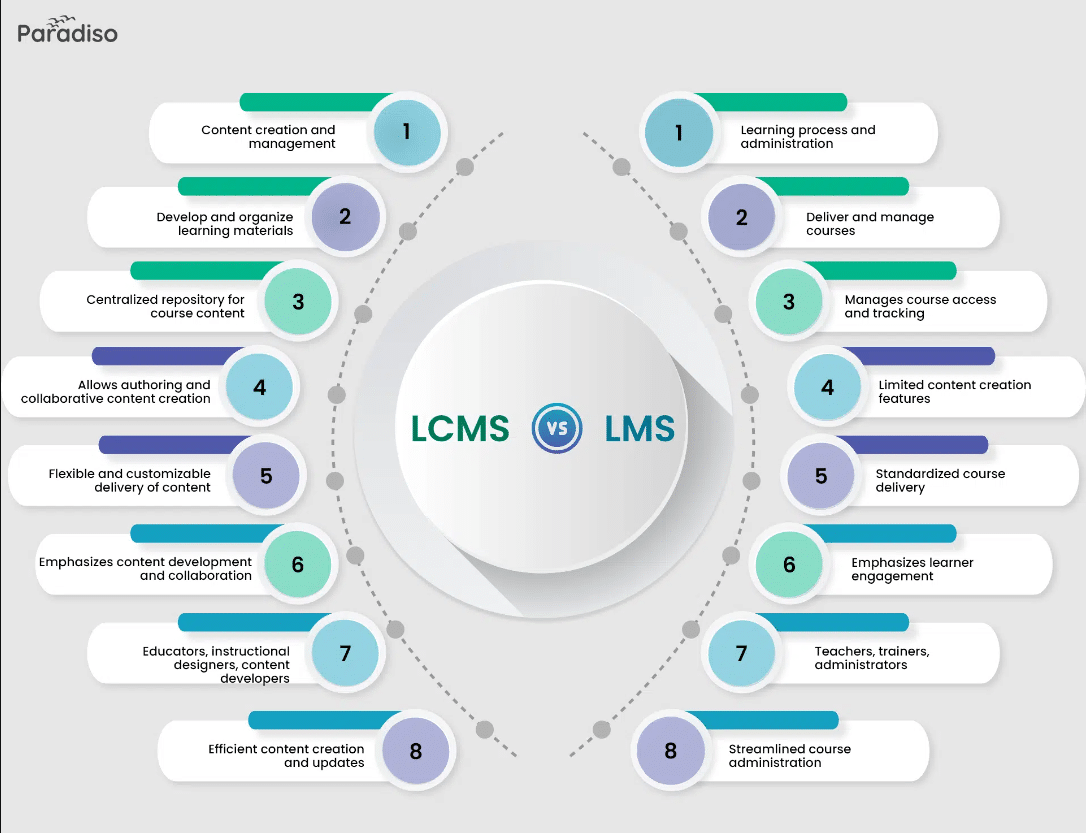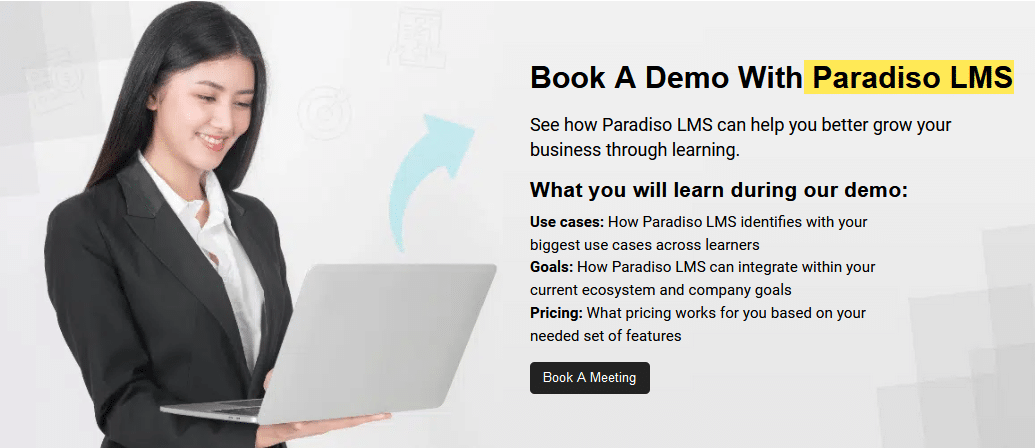In today’s fast-paced digital world, delivering effective learning experiences has become crucial for educators, trainers, and organizations. A Learning Content Management System (LCMS) is an advanced platform that streamlines the creation, management, and distribution of educational content, making it a game-changer in the realm of learning and development.
What is a Learning Content Management System (LCMS)?

Unlike traditional Learning Management Systems (LMS) that primarily manage the delivery of learning materials, an LCMS offers comprehensive content authoring and collaborative tools, making it the ideal solution for designing interactive and personalized learning experiences. But what exactly is an LCMS, and how does it differ from an LMS?
Let’s dive into the features and benefits that set an LCMS apart and explore how it can revolutionize the way learning content is created and shared.
LCMS vs. LMS: Why are the names so similar?
(Learning Management System) focuses on course delivery, learner progress, and assessments. LCMS (Learning Content Management System) emphasizes content creation, organization, and collaborative authoring for efficient multi-channel content delivery. Both are key in e-learning, hence their similar names.
LCMS vs LMS: What’s the Difference?
Both LCMS and LMS are critical components of modern e-learning, but they serve distinct purposes.
LMS (Learning Management System)
An LMS focuses on delivering educational content, managing learners, and tracking their progress. LMS platforms are widely used for administering training programs, managing student enrollment, and tracking assessment scores. The primary purpose of an LMS is to manage the learning process, offering an organized environment where learners can access course materials, complete assignments, and participate in discussions.
Discover the power of streamlined content creation and delivery with an LCMS. Book a Demo Now to explore how it can transform your learning experience!”
LCMS (Learning Content Management System)
However, an LCMS is more concerned with creating, managing, and updating learning content. It provides tools for content creators—such as instructional designers and subject matter experts—to collaborate on developing engaging, interactive, and personalized learning materials. An LCMS enhances efficiency by allowing seamless updates and repurposing of content, making it more dynamic compared to a standard LMS.

Key Features of a Learning Content Management System
An LCMS stands out due to its advanced features that simplify and enhance content creation, management, and delivery. Let’s explore some of the core functionalities that make an LCMS a powerful tool:
-
Collaborative Content Creation
An LCMS enables multiple contributors to work on the same project simultaneously, allowing subject matter experts, instructional designers, and educators to combine their expertise in real-time, resulting in high-quality, diverse content.
-
Dynamic Content Management
Unlike traditional LMSs, an LCMS simplifies content updates, allowing educators to easily revise materials and keep content current, crucial in rapidly changing fields.
-
Efficient Content Reuse
LCMSs allow content to be reused across courses, saving time and reducing redundancy. Multimedia assets, quizzes, and lessons can be easily repurposed, enhancing scalability.
-
Personalized Learning Paths
LCMSs enable personalized learning by adapting content to individual learners’ needs and pace, creating a more engaging and effective educational experience.
-
Multichannel Content Delivery
LCMSs support content delivery across multiple platforms, allowing learners to access materials via e-learning websites, mobile apps, or virtual classrooms on various devices.
-
Advanced Analytics and Reporting
LCMSs provide detailed analytics and reporting, offering insights into learner behavior and content performance, enabling continuous improvement of learning materials.
Let’s know the benefits of using an LCMS
Incorporating an LCMS into your organization or educational institution offers numerous benefits, which include:
-
Streamlined Content Creation
An LCMS accelerates content creation with built-in authoring tools, eliminating external software and reducing costs.
-
Cost and Time Efficiency
LCMSs save time and money by enabling content reuse and easy updates, minimizing the need for new material development.
-
Enhanced Learner Engagement
Multimedia, simulations, and gamification in LCMSs create interactive, engaging experiences that improve learner motivation and retention.
-
Scalability
LCMSs support efficient scaling of educational programs by enabling content reuse and multichannel distribution, similar to how a distribution management system ensures seamless delivery of products across multiple channels.
Top Learning Content Management Systems (LCMS)
If you’re exploring options for adopting a Learning Content Management System (LCMS), here are some top platforms that stand out for their unique features:
1. Paradiso
Paradiso LMS is a versatile platform known for its extensive multimedia integration, making it easy to create engaging content. It also offers powerful reporting tools, enabling educators and administrators to track learner progress and optimize materials effectively. Its flexibility makes it suitable for both academic institutions and corporate training.
Discover the power of streamlined content creation and delivery with an LCMS. Book a Demo Now to explore how it can transform your learning experience!”
2. Coassemble
Coassemble is highly regarded for its intuitive, user-friendly interface, which simplifies the content creation process. With strong collaborative features, it allows multiple team members to contribute to course development, ensuring high-quality, diverse content. It’s a great option for teams seeking ease of use and seamless collaboration.
3. Freestone
Freestone offers advanced tools specifically tailored for virtual events and professional education. It excels in managing live and on-demand webinars, making it a top choice for organizations that frequently conduct virtual training or educational events. Its ability to blend live and self-paced learning adds to its appeal.
4. Tovuti
Tovuti is a comprehensive LCMS with built-in gamification and social learning tools, which enhance learner engagement. Its customizable learning paths and robust analytics make it a popular choice for those looking to foster a community-driven learning environment. Ideal for organizations that prioritize learner interaction and motivation.
5. Absorb LMS
Absorb LMS focuses on content creation that is both robust and adaptable. Its mobile-friendly design ensures learners can access content anywhere, making it a flexible option for both remote and on-site learners. With an emphasis on user experience, Absorb LMS is suitable for organizations looking to scale their learning programs effectively.
Is an LCMS Right for You?
Choosing an LCMS depends on your organization’s needs. If you prioritize content creation, collaboration, and dynamic updates, then an LCMS is an ideal solution. It offers the tools to empower content creators, deliver personalized learning experiences, and ensure that your educational content remains engaging and up-to-date.
In conclusion, a Learning Content Management System can revolutionize how educational content is developed, managed, and delivered. By leveraging the power of collaboration, personalization, and analytics, an LCMS provides a scalable and efficient way to enhance learning experiences for educators, trainers, and learners alike.












